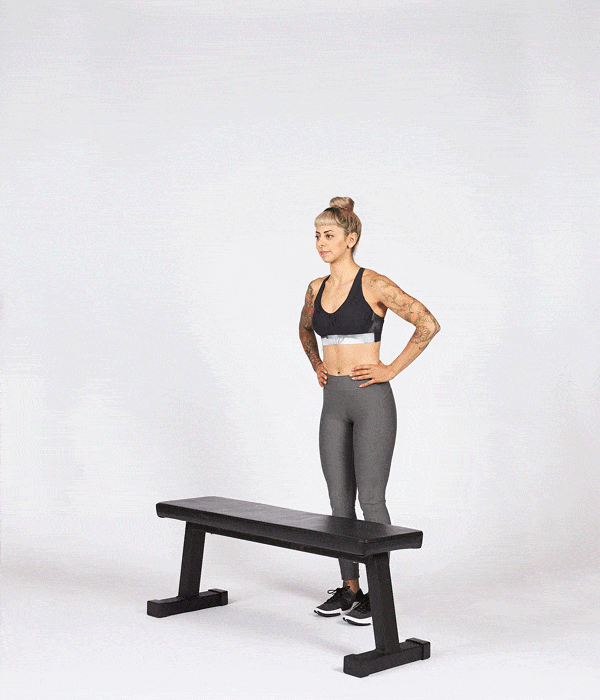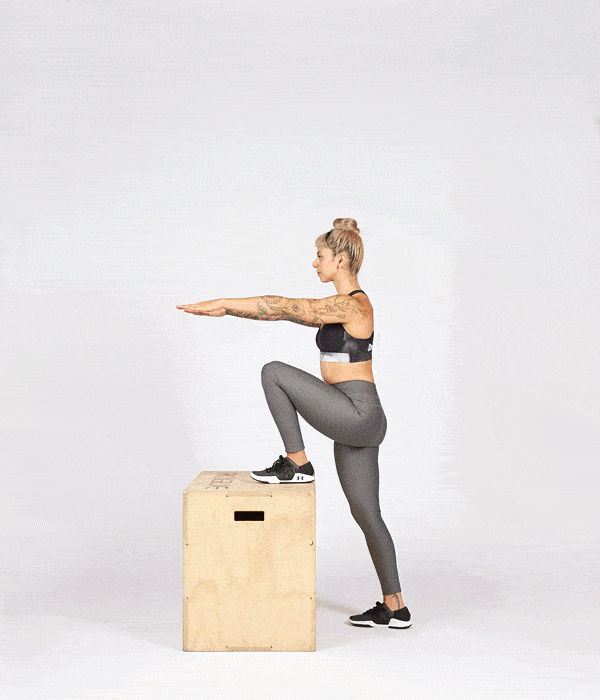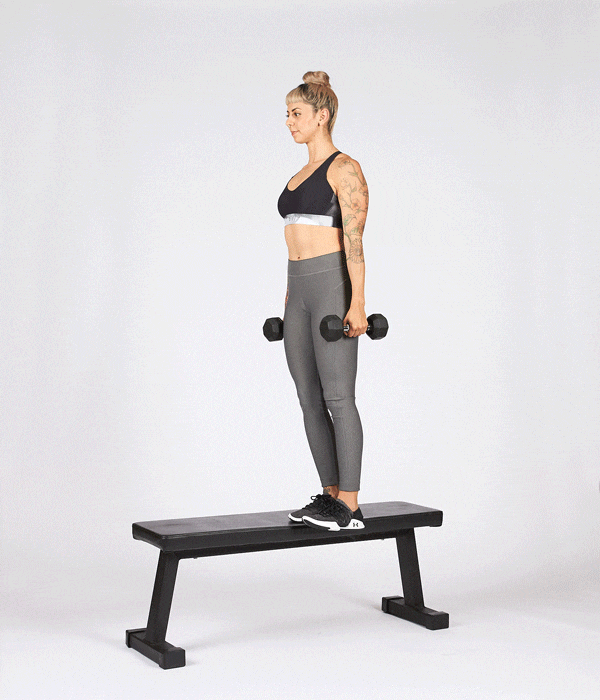The stepup, a simple leg exercise performed by stepping up onto an elevated surface like a bench or box, can take on very different forms depending on your fitness goal. Most homes and even hotel rooms have enough equipment to perform a stepup workout. All you need is the right surface, basic equipment and a little imagination to get a full leg workout.
The surface you use for stepups should be about knee height and flat on top. Using a cushioned chair or couch is tempting, but the cushion will throw your balance off and make your ankle unstable.
If you have trouble balancing and are worried you’ll fall, start with a very low box. You can even use something ankle height. Some fitness companies sell aerobic steps, which are adjustable. Whatever you choose, try it first to make sure the height is appropriate and not dangerous.

AEROBIC STEPUPS
You can use the stepup as a form of cardio in the same way you’d use stairs. In fact, performing this exercise for 2 minutes straight is a way to test your aerobic capacity, according to a 2019 study published in the Journal of Geriatric Physical Therapy. Every rep you’re fighting gravity with your leg muscles. To make it harder, all you have to do is increase your step frequency. Don’t use any weight for this exercise because the emphasis is on speed.
The move: Plant your right foot on the box, lean forward and step up so you’re standing with both feet on the box. Then, step back with your right foot and plant it on the ground. Then, step back with your left foot. Next, step up with your left foot followed by the right foot. Each repetition you’ll switch feet.

DUMBBELL STEPUPS
Instead of focusing on speed, this variation adds weight and turns the stepup into a muscle-building exercise.
The move: Hold a dumbbell in each hand by your sides, and put your right foot on the box or bench. Lean forward and step up so you’re standing on the box, keeping your knee in line with your second toe as you step up. Then, step back with your left foot. Instead of alternating every rep, stay on the same leg until you’ve completed 10 repetitions, then switch sides. If you switch too early you might not fatigue the muscle.

GOBLET STEPUPS
This variation is similar to the dumbbell stepup, but you hold a kettlebell or dumbbell in front of your chest like a goblet. If you’re using a kettlebell, hold it by the sides of the handles. If you’re using a dumbbell, hold it at the top with the weight vertical. The weight in front of your body will help pull you forward as you step up to the box, which might feel more natural than holding dumbbells by your side.
The move: Holding your weight in the goblet position, plant your right foot on the box and step up with your left foot. Step back with the left foot and perform 10 repetitions before switching legs.

LATERAL STEPUPS
The traditional stepup starts behind the box and goes straight forward and up. It’s similar to most other leg exercises because it’s a straightforward movement. To switch things up and work different parts of your leg, such as the adductor muscles of the inner thigh, you can perform the stepup at an angle.
The move: Instead of standing behind the box, stand to the left side. Plant your right foot on the box. Make sure you leave enough room for your left foot to join. Step up and to the side so both feet are on the box, then step back down with the left leg.

HIGH BOX STEPUPS
Making an exercise harder usually means adding weight, but you can also increase the range of motion.
The move: Do regular stepups, but use a higher box or surface than usual as long as you don’t feel like you’ll fall or lose balance. Even raising it 6 inches dramatically increases the difficulty. Add light weights to make it even harder. You can step up with the same leg for 10 reps on each side or alternate legs every rep.

SLOW NEGATIVE STEPUPS
The focus during stepups is usually on the upward motion of the movement or when you step up to the box. Then you quickly step back and down, preparing for the next rep. This is the correct way to do the movement, but you’re missing out on some potential muscle-building benefits from the negative portion of the movement, where you step back and down.
The move: Instead of rushing, slowly kick your leg back and drop your foot down to the ground. Try to count 3 seconds on the way down. The negative (or eccentric) portion of a movement is just as important for building muscle as the concentric portion, according to a 2017 study published in Frontiers in Physiology.

BARBELL STEPUPS
The stronger you become, the more difficult it is to hold heavy dumbbells by your sides during stepups. Holding the weights begins to hurt your forearms more than it does your legs. You can use a barbell across your upper back to make the exercise harder, instead of holding weights.
The move: Put the bar on your upper back and grip it with your hands wider than shoulder-width apart. Plant your foot on the box and step up, staying on one leg for 10 reps. Make sure the box you’re using isn’t too high, because the barbell can make it more difficult to balance.

SINGLE-LEG SQUATS OFF THE BOX
Instead of coming all the way back down to the ground between reps, you can keep the tension on your leg by doing single-leg squats. Stand at the top of the box, all the way to the right side.
The move: Hold light dumbbells in each hand. Reach your arms out in front before you start. This gives you a counterweight to help you balance. Kick your right leg out to the side like you’re doing a lateral stepup. Squat down with all your weight on your left leg. Go as low as you can without your right foot touching the ground, then stand back up and relax your arms. Repeat on the left leg until you’re tired, then move to the left side of the box and switch legs.

EXPLOSIVE STEPUPS
If you’re a sprinter, basketball player or play a sport that requires explosiveness, you can use the stepup to build speed and power.
The move: Start with a relatively small box, below knee-height. Plant your right foot on the box. Lean forward and step up as fast as possible, jumping off the box with your right leg. Land on the right leg as you step back with your left leg. Repeat 10 times on your right leg before switching to your left. Don’t use weight for this exercise. Instead, focus on jumping higher every rep. You can slowly increase the height of the box.
Ready to take the next step? Unlock MyFitnessPal Premium to access custom goal settings, quick-log recipes, and guided plans from a registered dietitian. Premium users are 65% more likely to reach their weight loss goals!




